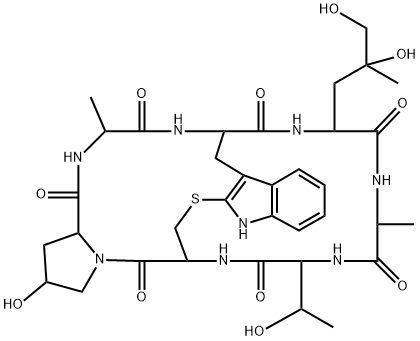
PHALLOIDIN
- Product NamePHALLOIDIN
- CAS17466-45-4
- CBNumberCB6458766
- MFC35H48N8O11S
- MW788.87
- EINECS241-484-5
- MDL NumberMFCD06201852
- MOL File17466-45-4.mol
- MSDS FileSDS
Chemical Properties
| Melting point | 280-282° |
| alpha | +55.7°(D/20℃)(c=0.5,メタノール) |
| Density | 1.1612 (rough estimate) |
| refractive index | 1.7400 (estimate) |
| storage temp. | +2C to +8C |
| solubility | DMF: 10 mg/ml; DMSO: 10 mg/ml; Ethanol: 10 mg/ml; Water: 0.5 mg/ml (warm) |
| form | White crystalline solid |
| Boiling point | 1370.5±65.0 °C(Predicted) |
| pka | 13.03±0.70(Predicted) |
| color | Hexahydrate, needles or crystals from water |
| optical activity | +62.3 (Ethanol) |
| biological source | Amanita phalloides |
| Water Solubility | Soluble to 1 mg/ml in water |
| Merck | 13,7273 |
| BRN | 4347460 |
| Stability | Stable. Incompatible with strong oxidizing agents. |
| EWG's Food Scores | 1 |
| FDA UNII | 5A520O87TI |
Safety
| Symbol(GHS) |

|
|||||||||
| Signal word | Danger | |||||||||
| Hazard statements | H300+H310+H330 | |||||||||
| Precautionary statements | P260-P262-P264-P280-P302+P352+P310-P304+P340+P310 | |||||||||
| Hazard Codes | T+ | |||||||||
| Risk Statements | 26/27/28 | |||||||||
| Safety Statements | 22-28-36/37-45 | |||||||||
| RIDADR | UN 3462 6.1/PG 2 | |||||||||
| WGK Germany | 3 | |||||||||
| RTECS | SE9800000 | |||||||||
| F | 18 | |||||||||
| HazardClass | 6.1(a) | |||||||||
| PackingGroup | I | |||||||||
| HS Code | 2934999090 | |||||||||
| Hazardous Substances Data | 17466-45-4(Hazardous Substances Data) | |||||||||
| Toxicity | LD50 i.m. in albino mice: 3.3 mg/g (Vogt); LD50 i.p. in mice: 2 mg/kg (Wieland, Wieland) | |||||||||
| NFPA 704: |
|
